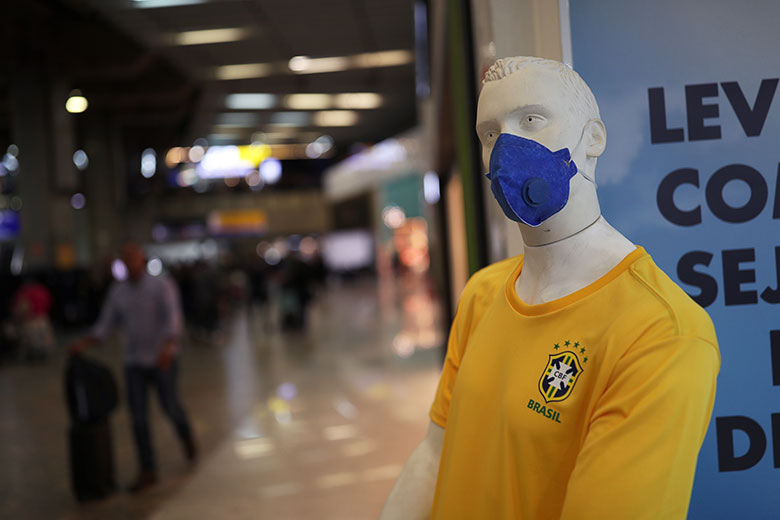Brazil is on the other side of the world from China, the epicentre of the coronavirus, but it has become one of the countries most directly impacted by the disease – which is a huge headache for the Central Bank of Brazil (BCB) and finance ministry.
The Brazilian real has been accelerating its depreciation trend in recent days – on Wednesday the dollar closed at $4.58, a fall of 1.5% in the day’s session, and by Thursday the real had fallen 13.9% in 2020.
The fresh falls came despite the BCB’s announcement it would conduct a fresh intervention in the FX market, selling swaps valued at $1 billion.
The problem for Roberto Campos Neto, BCB president, is that the market is pricing in fresh cuts to Selic, the bank’s base rate, after the decision by the US Fed to cut its base rate by 50 basis points.
The downward pressure on interest rates caused globally by the Covid-19 virus also fed into disappointing GDP data that preceded the crisis: on Wednesday, Brazil’s 2019 4Q GDP confirmed that last year the economy grew at just 1.1%, lower than the 1.3% registered in 2018.
That the poor growth result preceded the impact of Covid-19 led to a slew of downward revisions to economists’ forecasts for 2020 GDP and expectations of fresh rounds of monetary stimulus.
China slowdown
Brazil is likely to feel a large negative impact from the slowdown in China, given that 27.6% of its exports go to that single market – IMF data for the first two quarters of 2019 – and more broadly is exposed to the falling commodity prices caused by the crisis.
There will also likely be a material negative supply shock, as components imported from China into the Brazilian manufacturing process stop arriving at Brazilian ports.
On Tuesday, the BCB issued a communication to the market saying: “In light of the recent events, the economic impact of the global slowdown on the Brazilian economy tends to dominate an eventual deterioration of prices of financial asset prices.”
We are of the view that [Latin American] regional central banks will also lean to additional easing
- Alberto Ramos, Goldman Sachs
In a client report, Citi pointed out that that sentence modifies the BCB monetary policy committee’s (Copom) assessment about the impacts of the Covid-19 outbreak on the monetary policy balance of risks, “strengthening significantly the likelihood of new Selic rate cut on March 18”.
This statement fed into the deteriorating market sentiment about Brazilian growth in 2020. For example, on Wednesday, Capital Economics lowered its 2020 GDP forecast to 1.3% (from 1.5%).
As well as complicating the challenge to the central bank, the negative impact of the Covid-19 – which should start to be felt in Brazilian economic activity data in the coming months – raises the political stakes for Paulo Guedes, minister of finance, who was recently tasked by the country’s president Jair Bolsonaro to ensure this year’s growth was at least 2.0%.
Goldman Sachs was just one of the investment banks that reacted to recent events by cutting its forecast for Selic at the end of 2020 to 3.75% from 4.25%.
Such projections are adding to the weakness of the real as it further reduces both the attractiveness of the country for fixed income inflows and the likely volume of Brazilian companies raising debt abroad to finance local operations, as local debt becomes ever cheaper.
FX valuations
Given these fundamentals – Brazil’s current-account deficit has also been widening in recent months – the role of economic growth becomes an even more central driver of FX valuations and the growing downward expectations complicate the BCB’s policy challenge even further.
According to Alberto Ramos, Latin America economist at Goldman Sachs, the rising risk aversion and risk premia that is leading to the depreciation in the real could be accentuated if the central bank cuts interest rates and is bad for investors seeking carry.
“This could limit the policy room for easing,” he says. “However, given that the nature and the severity of the shock to real activity, and the fact that, absent rate cuts, relative monetary conditions would be tightened against the US Fed, most of the G10 and many other large EMs, we are of the view that [Latin American] regional central banks will also lean to additional easing.”
Ramos says that if pushed down the path of further interest-rate cuts, he expects central banks in Latin America will try to limit depreciation by intervening in the currency markets.
However, the experience of Brazil – where markets seem to have shrugged off growing intervention as ineffective – shows that fighting such pressures may be futile and expensive.
While the hit to the Brazilian economy is the highest profile in the region – due to the headlines created by the sliding real – other economies are also vulnerable to a prolonged cessation in demand from China.
Chile sends 30% of its exports – mostly iron ore – to China, while Peru (29.5%) and Uruguay (24%) also have large direct exposures to the world’s second-largest economy.
Goldman Sachs has revised across the board: in Brazil its 2020 GDP forecast is now 1.5% (from 2.2%), Peru is now 2.8% (from 3.3%), Colombia is 3.0% (from 3.4%) and Mexico is now forecast to grow at 0.6% (from 1.0%).


 Signal2forex.com - Best robots Forex sy famantarana
Signal2forex.com - Best robots Forex sy famantarana




